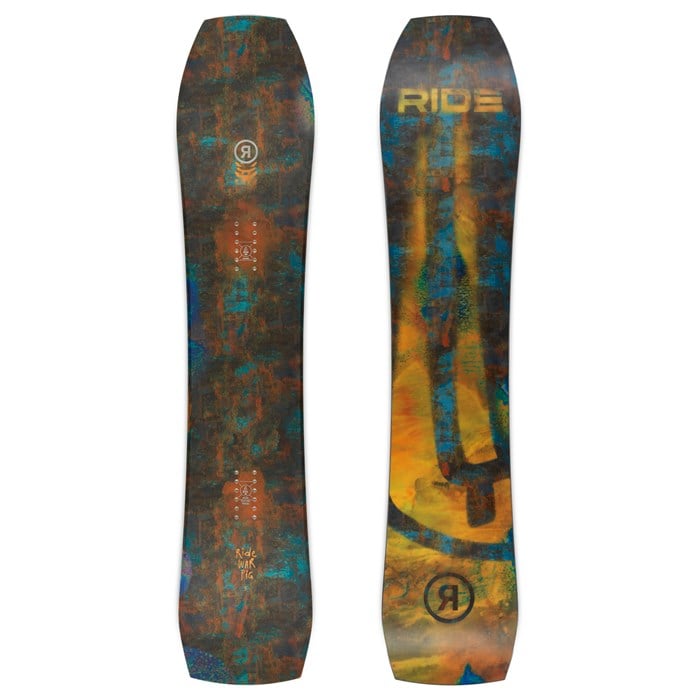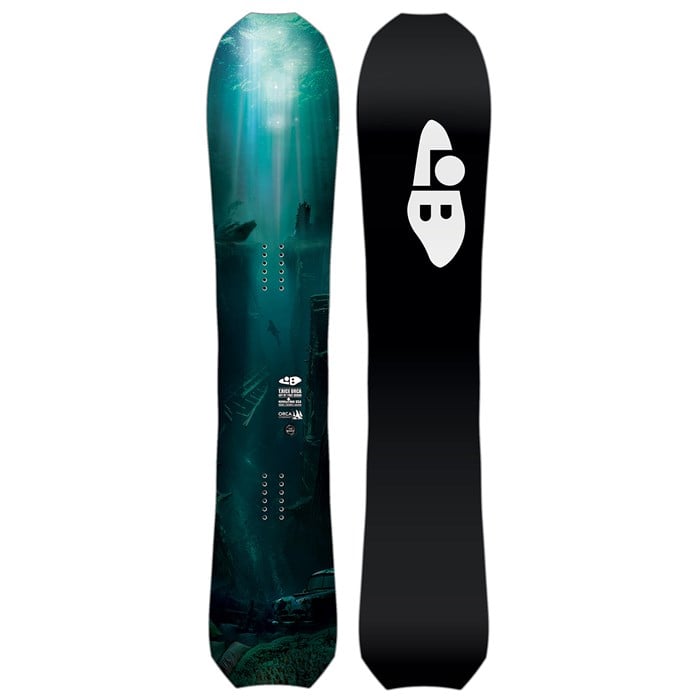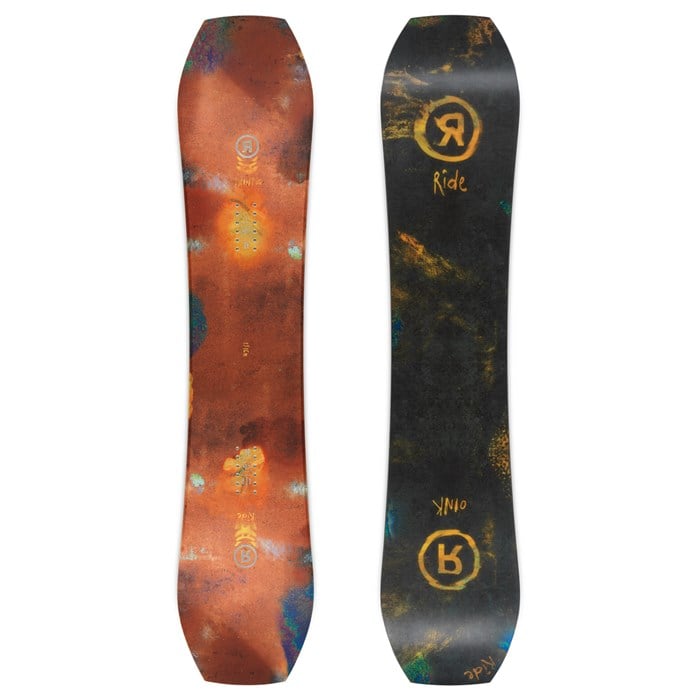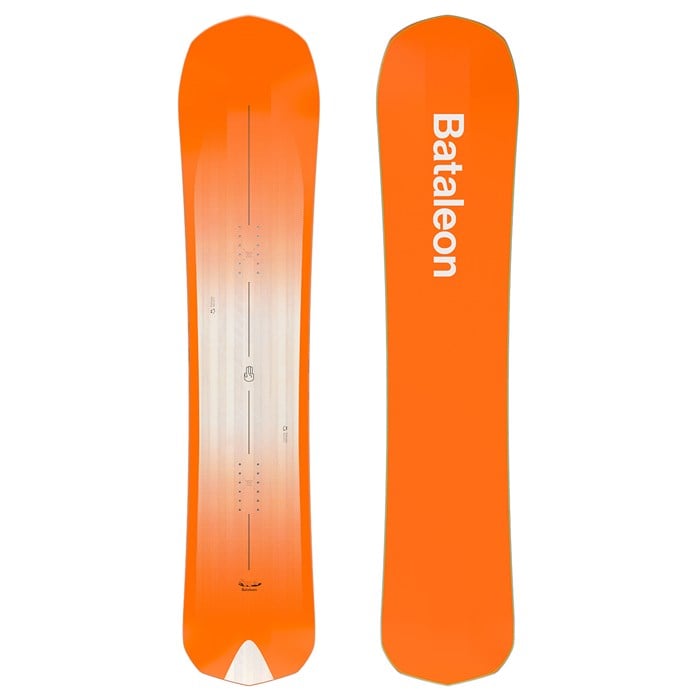Volume shifted boards used to be a niche experiment. Now they’re just normal. Short, wide and stupid fun (when you pick the right one).
You get powder float without the extra length, plus the quick, playful feel of a freestyle deck that still bites on hardpack.
I ran a stack of 2026 shapes through Jackson and Whistler this season in wind buff, refrozen mornings and late-day chop. Some were money. Others rode like oversized planks. These are the ones that actually deliver. Boards you can take anywhere without babysitting them.
🏆 Best Volume Shifted Snowboard 2026
The Ride Warpig still holds the crown for 2026. It’s the board that kicked off the whole volume-shift craze and it’s only gotten better. Fast, surfy and stupid fun — whether you’re slashing pow, ripping spring corn, or hunting side hits, the Warpig just works.
Top Volume Shifted Snowboards
- Best Overall: Ride Warpig
- Freeride Pick: Lib Tech Orca
- Powder Pick: Jones Storm Chaser
- Freestyle Pick: Ride Twinpig
- Budget Pick: Bataleon Party Wave
Best Volume Shifted Snowboards 2026
1. The Ride Warpig Best Overall Pick
- Flex: Medium (5/10)
- Profile: Directional zero
- Base: Sintered 4000
- Shape: Tapered bi-radial
- Match: Rome Katana bindings
- Extras: Performance™ core, Slim Walls
Details:
Short, wide, tapered. The Warpig locks a clean carve and stays calm when you open it up. The profile has enough rocker to float without feeling washy on hardpack. Ride’s Slim Wall sidewalls mute chatter and take the sting out of rough snow, while the carbon gives it snap out of a turn. It is a true volume-shift shape, so you size down and still get real surface area and stability.
My experience:
The Warpig felt dialed from run one. It rolls over quicker than it looks, bites well across the fall line and loves short swings in trees. On open groomers it lays a trench and holds speed without getting nervous. Side hits and medium features were easy to push without the tail folding. Landings felt kinder than they should, which I put down to the sidewalls doing their job. On real ice it needs a sharp tune and a steady foot. There are boards with more bite in that specific scenario, but it is a small trade for how good it rides everywhere else.
Bottom line:
Fun, fast and way more versatile than the shape suggests. If you want a volume-shifted deck that floats, carves and still plays in the park, the Warpig is an easy pick. It rewards a centered, active rider and pays you back with grip, pop and a smooth ride in rough snow. Easily one of this seasons top all-mountain snowboards.
Pros
- Great all-mountain versatility
- Fun, playful shape
- Premium build quality
- Can size down for quicker handling
- Poppy and responsive ride
Cons
- Edge-to-edge speed slightly slower due to extra width
2. The Lib Tech T.Rice Orca Best Freeride Pick
- Flex: 6-7/10
- Profile: Hybrid C2x
- Base: Sintered knife-cut
- Shape: Tapered directional
- Pairs With: Bent Metal Transfers
- Extras: Magne-Traction
Details:
The Orca looks loud and rides louder. Short, wide and directional with that Travis Rice stamp, it is a true volume shifted shape you size down. Lib Tech’s C2x hybrid gives you camber control with a touch of rocker for easy planing. Magne-Traction’s serrated edges bite on firm snow and hold a line when things get slick. The eco-minded build is classic Mervin: recycled content where it counts and tough enough to take a beating. This is a freeride tool first, not a park twin.
My experience:
From the first run it felt quick and lively, not sluggish like some wide decks. It snaps edge to edge, slashes clean in trees and planes fast when it gets deep. On refrozen mornings the Magne-Traction does real work. You can set a high edge angle and trust it to stick through shiny patches. It handles speed well and loves fall line turns. Switch and jib laps are not its thing, and in tight bumps the extra width takes a bit of management. Size it down and stay centered over the camber and it rewards you with drive and confidence.
Verdict:
Freeride and sidecountry killer. If you want float, edge grip and a board that still feels quick in traffic, the Orca is an easy yes. If your day is rails and true switch landings, look elsewhere. For storm days, steep groomers and mixed resort chop, it delivers without fuss.
Pros
- Exceptional for long, drawn-out carves
- Performs excellently on groomers and powder
- Very stable at high speeds
- Sleek, eye-catching design
- Handles butters better than expected
Cons
- Heavier than average boards
- Stiff flex may challenge lighter or beginner riders
3. The Jones Storm Chaser Best Powder Pick
- Flex: 7/10
- Profile: Christenson Surf Rocker
- Base: Sintered 8000
- Shape: Directional
- Pairs With: Jones Meteorite Surfs
- Extras: 3D Contour Base 3.0, Progressive Sidecut
Details:
Short, wide and built like a little surf craft. The Storm Chaser has a deep rocker that keeps the nose up in real snow and a heavy taper that lets it roll edge to edge quicker than you expect. Traction Tech 3.0 helps it hold on the firm stuff and the bamboo surf core keeps it lively without feeling twitchy. The sintered 8000 base is fast and shrugs off abuse once you wax it right. Size it down and let the width do the work.
My experience:
I first rode it on a storm day in Japan when the snow was up to my shins standing still. I dropped into a tight tree line, set a soft heel edge and the board just started planing. Zero drama. It felt like cheating. I caught myself laughing in my helmet which almost never happens anymore. It slashes clean, pivots on a dime and bounces through pillows without digging the nose. On groomers it is better than it looks, but you have to ride the sidecut and stay light on the back foot. In late day chop the short tail can get slapped around if you are lazy. On true ice you will still want a careful tune and a steady edge. I paired it with a medium stiff binding which helped keep the front foot honest.
Verdict:
If your happy place is storm days, trees and lower angle powder, the Storm Chaser is a blast. It floats, it slashes and it makes slow terrain feel fun again. It is not a park board and it is not the call for boilerplate hardpack. For more range and big mountain days I would grab the Orca. For deep snow and tight lines, this is the board that turns you into a grin machine.
Pros
- Incredibly nimble in tight tree runs
- Excels in deep powder
- Eco-conscious materials and construction
- Top performance proven in testing
- Designed by Jeremy Jones & Chris Christenson
Cons
- Less versatile across all conditions
- Premium price point
4. The Ride Twinpig Best Freestyle Pick
- Flex: 5.5/10
- Profile: Twin Standard Camber (Hybrid)
- Base: Sintered, fast and durable
- Shape: True Twin for freestyle symmetry
- Pairs With: Rome Katana bindings
- Extra Features: Asymmetrical Sidecut, Double Impact Plates, Cleave Edge™
Details:
Think Warpig DNA in a true twin. The TwinPig keeps the short and wide vibe, adds a centered stance and feels the same riding regular or switch. The asymmetric sidecut helps heelside feel as solid as toeside. Hybrid rocker gives easy presses with real bite between the feet. Ride’s Slimewalls smooth out chatter. Cleave Edge steel and Double Impact Plates are there for park abuse. Size it down and let the width carry you.
My experience:
This one felt like a cheat code on side hits and small jumps. Switch felt identical to regular, which makes cab spins way less sketchy. On a windy Whistler day I cased a hip and expected the tail to fold. It didn’t. The board stayed tracking and I rode it out clean. It butters without trying, locks on simple rails and still carves a proper turn when you point it down the fall line. On proper ice you do need to concentrate – it certainly won’t hold as reliably as a longer deck here. But that’s exactly what you’d expect, it’s just physics.
In deep snow it is rideable, just not the board I grab once it gets past boot top.
Verdict:
Freestyle first, all-mountain enough. If you want a playful twin you can size down that still carves and takes a hit, the TwinPig is a killer pick. Not the call for deep storm days or big mountain speed, but for park laps, side hits and messing around all over the hill, it delivers.
Pros
- Excellent volume-shifted park board
- Double blunted nose for effortless spins
- Wider waist adds stability on landings
- Built tough for long-lasting durability
Cons
- Not ideal unless you’re park-focused or part of a quiver
5. Bataleon Party Wave Best Budget Pick
- Flex: 4/10
- Profile: Camber for responsive rides
- Base: Sintered Hyper Glide S
- Shape: Directional
- Pair With: Rome Crux bindings
- Features: SideKick, 3BT™ technology
Details:
Short, wide, directional. 3BT with SideKick lets it release clean in soft snow and roll smoothly onto edge without the hooky feel some short-wides get. Medium camber gives it real control on piste, while the urethane Flex Walls take the sting out of choppy resort snow. Hyper Glide S base keeps it moving if you keep it waxed, and the poplar/beech “Core Core” adds snap without making it twitchy. Plan to size down 5–10 cm.
My Experience:
I ran it through storm days and a few firm mornings at Whistler. In trees it reacts to small inputs, which keeps the legs fresh. Crossing the long traverse under Symphony, it held speed where I usually start skating. On late-day chop off Peak Chair I cut across a mess of ruts and it stayed composed instead of chattering me off line. It will carve if you commit to the edge and let the sidecut do the work; it just prefers a smooth, centered style over ham-fisted trenching. When it’s scraped off you’ll get more reward from clean technique than brute force – I’m always more cautious with 3BT boards in harder conditions (though maybe thats a technique issue).
Verdict:
Daily-driver fun for riders who want easy float, quick direction changes and a forgiving feel all around the resort. Not built for race-board carves or the biggest jumps, but for storm laps, side hits and mixed resort snow, it does more than its “pow board” specs suggests. An all-around super fun deck.
Pros
- Fun and budget-friendly choice
- Can ride 5–10cm shorter
- New pin tail helps with switch riding
- 3BT makes transitions effortless
- Surprisingly good carver
- Upgraded sintered base (2024)
Cons
- Old swallowtail version handled powder better
- Flex a bit soft for heavier riders (consider Party Wave +)
Comparison Table
| Snowboard | Flex | Profile | Base | Riding Style | Rating | Price |
|---|---|---|---|---|---|---|
| The Ride Warpig | 5 | Directional Zero Camber | Sintered | All-Mountain | 9.5 | $549 |
| The Lib Tech T.Rice Orca | 6-7 | Hybrid C2x | Sintered Knife-Cut Base | All-Mountain Freeride | 9.3 | $699 |
| The Jones Storm Chaser | 7 | Christenson Surf Rocker | Sintered 8000 | Powder! | 9.2 | $649 |
| The Ride Twinpig | 5.5 | Twin Standard Camber (Hybrid) | Sintered | All-Mountain Freestyle | 9.1 | $529 |
| Bataleon Party Wave | 4 | Camber | Sintered (Hyper Glide S) | All-Mountain Freeride | 9.0 | $459 |
Volume Shifted Snowboards Explained
What are they?
Volume shifted snowboards are shorter, wider boards that borrow the idea from fish surfboards. You trade a few centimeters of length for extra width and surface area, usually with more nose, some taper and a slightly set-back stance. The goal is simple: keep the board nimble while adding easy float and stability.
How they work
Surface area without the length: Extra width underfoot and through the nose gives you lift in soft snow so you don’t need a 160+ just to stay on top.
Turn shape and control: Shorter running length makes turn initiation quick. Taper and sidecut help the tail release when you want it, while camber underfoot keeps things honest on groomers.
Boot clearance: More waist width reduces toe and heel drag, which helps bigger boots carve cleanly.
Should you get one?
Heck yeah! Grab a volume shifted board if you want quick turns in trees, easier float and an all-mountain board that still feels playful. Skip it if you live on boilerplate and only want long, high-speed carves every day.
Pros
Easy float in soft snow without sizing up
Quick, agile feel in trees and tight spots
Room for larger boots with less drag
Stable platform for side hits and landings
Cons
Slower edge-to-edge if you go too wide for your foot size
Long, high-speed carves on hard ice are not its sweet spot
Sizing wrong (too short or too wide) makes the ride feel crappy
Terrain performance
Powder: Pops on plane early and stays there. Less back-leg burn on low-angle runs.
Carving: Grippy and fun on normal groomers. For true ice or GS-style arcs, a traditional camber charger still wins.
Freestyle/Park: Short length and wide platform make spins, butters and small to medium jumps feel easy. Rails are fine if the base is tuned and you size smart.
Chop and crud: The extra platform helps. Look for models with good damping if your hill gets lumpy.
Sizing tips
Length: Start 5–10 cm shorter than your usual all-mountain size. Heavier riders or folks who want more stability can trim only 3–6 cm.
Width: Match the waist to your boots. As a rough guide, US 11+ often benefits from 260 mm+ at the waist, but do not overshoot or it will feel sluggish. Aim for minimal toe and heel overhang at your preferred angles.
Flex & profile: Medium flex with some camber underfoot gives you bite on piste. Rocker in the nose helps with planing and smooth turn entry.
Good examples
Ride Warpig: Short, wide and shockingly versatile for carving, side hits, and mixed days.
Lib Tech Orca: Extra width plus Magne-Traction for edge hold when it gets firm.
Jones Storm Chaser: Surf-leaning shape that makes deep days and tight trees easy.
Bataleon Party Wave: 3BT for forgiving edge engagement and playful resort riding.
Bottom line:
Volume shifted snowboards keep the fun parts of a shorter board and add the float and stability you usually need length for. Size it right, keep it waxed and it turns average resort days into good ones.
Final Thoughts
Turns out “volume shift” is not a marketing ploy or gimmick. Size it right and it makes resort days easier and more fun. You get real float without the plank feeling, quick turns in trees and a bigger landing zone for side hits.
Pick with intent. Drop 5 to 10 cm from your usual length, match waist width to your boots so overhang is minimal and choose a profile with some camber if your hill gets firm. Too wide feels sluggish, too short feels twitchy. Keep it waxed, keep a sharp tune for scraped mornings and let the board do the work.
If you have been riding a traditional 159, try a 152 in one of these. Give it two laps, then decide. Most riders don’t look back.
Volume Shifted Snowboard FAQs
- US 8 to 10: ~252 to 260 mm
- US 10.5 to 12: ~258 to 268 mm
- US 12+: ~265 mm and up






Ordered the warpig. Now we wait…
Great choice. Update us with a review once you’ve ridden it!
Mike